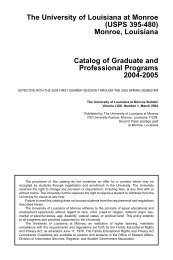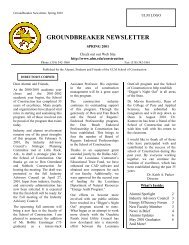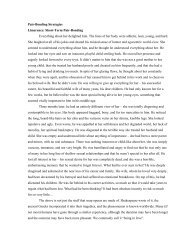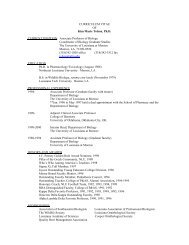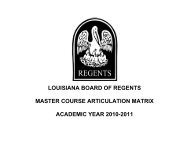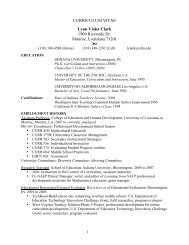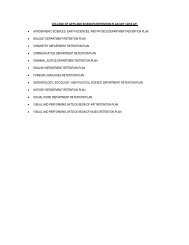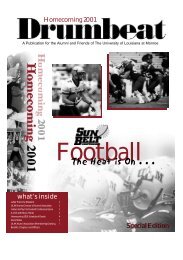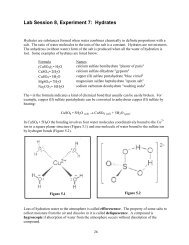Undergraduate Catalog - University of Louisiana at Monroe
Undergraduate Catalog - University of Louisiana at Monroe
Undergraduate Catalog - University of Louisiana at Monroe
You also want an ePaper? Increase the reach of your titles
YUMPU automatically turns print PDFs into web optimized ePapers that Google loves.
158 UNIVERSITY OF LOUISIANA MONROE 2012-2013 UNDERGRADUATE CATALOG<br />
A student must possess aptitude, abilities, and skills<br />
in five areas:<br />
1) observ<strong>at</strong>ion;<br />
2) communic<strong>at</strong>ion;<br />
3) sensory and motor coordin<strong>at</strong>ion and function;<br />
4) conceptualiz<strong>at</strong>ion, integr<strong>at</strong>ion and quantit<strong>at</strong>ive<br />
evalu<strong>at</strong>ion; and<br />
5) behavioral and social skills, abilities and aptitude.<br />
These are described in detail below. The program<br />
faculty will monitor maintenance <strong>of</strong> these standards.<br />
Students must be able to independently perform the<br />
described functions.<br />
1. OBSERVATION<br />
Students must be able to:<br />
a. observe demonstr<strong>at</strong>ions and conduct<br />
exercises in a variety <strong>of</strong> areas rel<strong>at</strong>ed to<br />
contemporary pharmacy practice, including<br />
but not limited to, monitoring <strong>of</strong> drug response<br />
and prepar<strong>at</strong>ion <strong>of</strong> specialty dosage forms.<br />
b. observe a p<strong>at</strong>ient accur<strong>at</strong>ely <strong>at</strong> a distance<br />
and close <strong>at</strong> hand, noting nonverbal as well<br />
as verbal signals. Specific vision-rel<strong>at</strong>ed<br />
requirements include, but are not limited to<br />
the following abilities:<br />
i. visualizing and discrimin<strong>at</strong>ing findings on<br />
drug or fluid monitoring tests;<br />
ii. reading written and illustr<strong>at</strong>ed m<strong>at</strong>erial;<br />
iii. observing demonstr<strong>at</strong>ions in the classroom<br />
or labor<strong>at</strong>ory, including projected<br />
slides and overheads;<br />
iv. observing and differenti<strong>at</strong>ing changes in<br />
body movement;<br />
v. observing an<strong>at</strong>omic structures;<br />
vi. discrimin<strong>at</strong>ing numbers and p<strong>at</strong>terns<br />
associ<strong>at</strong>ed with diagnostic and monitoring<br />
instruments and tests, and<br />
vii. competently using instruments for<br />
monitoring drug response.<br />
2. COMMUNICATION<br />
Students must be able to:<br />
a. rel<strong>at</strong>e effectively and sensitively with p<strong>at</strong>ients<br />
and their caregivers and or partners, and<br />
convey a sense <strong>of</strong> compassion and emp<strong>at</strong>hy.<br />
b. communic<strong>at</strong>e clearly with, and observe<br />
p<strong>at</strong>ients in order to elicit inform<strong>at</strong>ion,<br />
accur<strong>at</strong>ely describe changes in mood, activity<br />
and posture, and perceive verbal as well<br />
as nonverbal communic<strong>at</strong>ion. Communic<strong>at</strong>ion<br />
includes not only speech but also reading and<br />
writing. Communic<strong>at</strong>e quickly, effectively and<br />
efficiently in oral and written English with all<br />
members <strong>of</strong> the health care team. Specific<br />
requirements include but are not limited to the<br />
following abilities:<br />
i. communic<strong>at</strong>ing rapidly and clearly with<br />
the health care team on rounds;<br />
ii. eliciting a thorough history from p<strong>at</strong>ients; and<br />
iii. communic<strong>at</strong>ing complex findings in<br />
appropri<strong>at</strong>e terms to p<strong>at</strong>ients and their<br />
caregivers, partners and various members<br />
<strong>of</strong> the health care team (fellow students,<br />
physicians, nurses, aides, therapists,<br />
social workers, and others).<br />
c. learn to recognize and promptly respond to<br />
emotional communic<strong>at</strong>ion such as sadness,<br />
worry, agit<strong>at</strong>ion, and lack <strong>of</strong> comprehension <strong>of</strong><br />
communic<strong>at</strong>ion.<br />
d. recognize signs <strong>of</strong> behavioral disorders th<strong>at</strong><br />
may impact a p<strong>at</strong>ient’s compliance.<br />
e. read and record observ<strong>at</strong>ions and care plans<br />
legibly, efficiently and accur<strong>at</strong>ely.<br />
f. prepare and communic<strong>at</strong>e concise but<br />
complete summaries <strong>of</strong> individual encounters<br />
and complex, prolonged encounters with<br />
p<strong>at</strong>ients.<br />
g. complete forms or appropri<strong>at</strong>ely document<br />
activities according to directions in a complete<br />
and timely fashion.<br />
3. SENSORY AND MOTOR COORDINATION OR<br />
FUNCTION<br />
Students must have sufficient sensory and motor<br />
function to monitor drug response and to prepare and or<br />
dispense pharmaceuticals.<br />
A student should be able to execute motor<br />
movements reasonably required to particip<strong>at</strong>e in the<br />
general care and emergency tre<strong>at</strong>ment <strong>of</strong> p<strong>at</strong>ients. They<br />
must be able to respond promptly to urgencies within the<br />
practice setting and must not hinder the ability <strong>of</strong> their<br />
coworkers to provide prompt care. Examples <strong>of</strong> such<br />
emergency tre<strong>at</strong>ment reasonably required <strong>of</strong> pharmacists<br />
include arriving quickly when called, particip<strong>at</strong>ing in the<br />
initi<strong>at</strong>ion <strong>of</strong> appropri<strong>at</strong>e procedures, and rapidly and<br />
accur<strong>at</strong>ely preparing appropri<strong>at</strong>e emergency medic<strong>at</strong>ion.<br />
4. INTELLECTUAL-CONCEPTUAL INTEGRATIVE<br />
AND QUANTITATIVE ABILITIES<br />
These abilities include<br />
a. measurement,<br />
b. calcul<strong>at</strong>ion,<br />
c. reasoning,<br />
d. analysis,<br />
e. judgment,<br />
f. numerical recognition and<br />
g. synthesis.<br />
Especially important is the appropri<strong>at</strong>e and rapid<br />
calcul<strong>at</strong>ion <strong>of</strong> dosages in a variety <strong>of</strong> conditions such as<br />
renal or hep<strong>at</strong>ic failure, obesity, cardiac or respir<strong>at</strong>ory<br />
arrest, etc. Additionally, calcul<strong>at</strong>ions involving appropri<strong>at</strong>e<br />
dilution or reconstitution <strong>of</strong> drug products, electrolytes,<br />
etc. must be made accur<strong>at</strong>ely and quickly. Problem<br />
solving, a critical skill demanded <strong>of</strong> all pharmacists,<br />
requires all <strong>of</strong> these intellectual abilities and must be<br />
performed quickly, especially in emergency situ<strong>at</strong>ions.<br />
Students must be able to:<br />
a. identify significant findings from history,<br />
physical assessment, and labor<strong>at</strong>ory d<strong>at</strong>a;<br />
provide a reasonable explan<strong>at</strong>ion and<br />
analysis <strong>of</strong> the problem;




